lock TOYOTA COROLLA 2014 11.G Quick Reference Guide
[x] Cancel search | Manufacturer: TOYOTA, Model Year: 2014, Model line: COROLLA, Model: TOYOTA COROLLA 2014 11.GPages: 15, PDF Size: 6.61 MB
Page 2 of 15
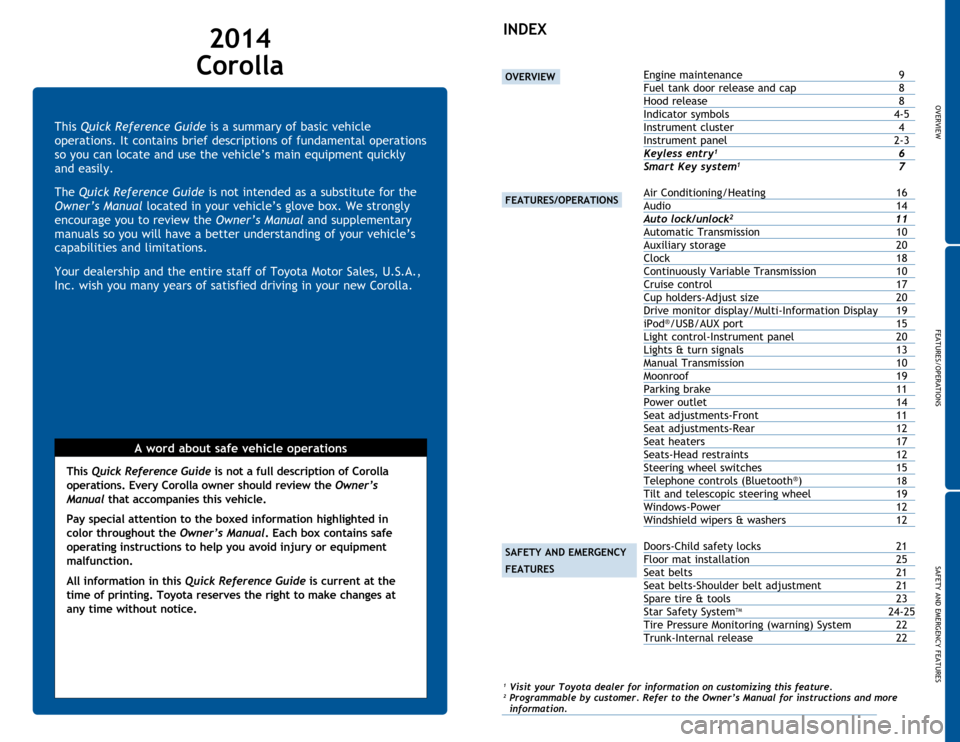
OVERVIEW
FEATURES/OPERATIONS
SAFETY AND EMERGENCY FEATURES
1
This Quick Reference Guide is a summary of basic vehicle
operations. It contains brief descriptions of fundamental operations
so you can locate and use the vehicle’s main equipment quickly
and easily.
The Quick Reference Guide is not intended as a substitute for the
Owner’s Manual located in your vehicle’s glove box. We strongly
encourage you to review the Owner’s Manual and supplementary
manuals so you will have a better understanding of your vehicle’s
capabilities and limitations.
Your dealership and the entire staff of Toyota Motor Sales, U.S.A.,
Inc. wish you many years of satisfied driving in your new Corolla.
A word about safe vehicle operations
This Quick Reference Guide is not a full description of Corolla
operations. Every Corolla owner should review the Owner’s
Manual that accompanies this vehicle.
Pay special attention to the boxed information highlighted in
color throughout the Owner’s Manual. Each box contains safe
operating instructions to help you avoid injury or equipment
malfunction.
All information in this Quick Reference Guide is current at the
time of printing. Toyota reserves the right to make changes at
any time without notice.
2014
Corolla
Engine maintenance 9
Fuel tank door release and cap 8
Hood release 8
Indicator symbols 4-5
Instrument cluster 4
Instrument panel 2-3
Keyless entry
1 6
Smart Key system1 7
Air Conditioning/Heating 16
Audio 14
Auto lock/unlock
2 11
Automatic Transmission 10
Auxiliary storage 20
Clock 18
Continuously Variable Transmission 10
Cruise control 17
Cup holders-Adjust size 20
Drive monitor display/Multi-Information Display 19
iPod
®/USB/AUX port 15
Light control-Instrument panel 20
Lights & turn signals 13
Manual Transmission 10
Moonroof 19
Parking brake 11
Power outlet 14
Seat adjustments-Front 11
Seat adjustments-Rear 12
Seat heaters 17
Seats-Head restraints 12
Steering wheel switches 15
Telephone controls (Bluetooth
®) 18
Tilt and telescopic steering wheel 19
Windows-Power 12
Windshield wipers & washers 12
Doors-Child safety locks 21
Floor mat installation 25
Seat belts 21
Seat belts-Shoulder belt adjustment 21
Spare tire & tools 23
Star Safety System
TM 24-25
Tire Pressure Monitoring (warning) System 22
Trunk-Internal release 22
1 Visit your Toyota dealer for information on customizing this feature.2 Programmable by customer. Refer to the Owner’s Manual for instructions and more
information.
INDEX
OVERVIEW
FEATURES/OPERATIONS
SAFETY AND EMERGENCY
FEATURES
Page 3 of 15
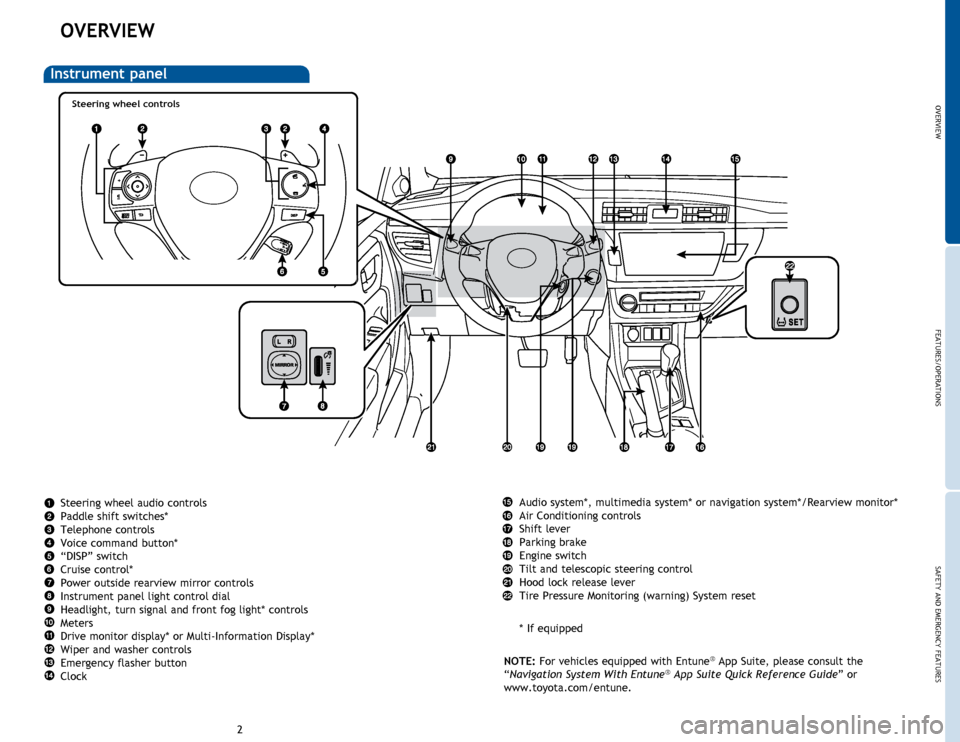
OVERVIEW
FEATURES/OPERATIONS
SAFETY AND EMERGENCY FEATURES
23
Audio system*, multimedia system* or navigation system*/Rearview monitor*
Air Conditioning controls
Shift lever
Parking brake
Engine switch
Tilt and telescopic steering control
Hood lock release lever
Tire Pressure Monitoring (warning) System reset
* If equipped
NOTE: For vehicles equipped with Entune
® App Suite, please consult the
“Navigation System With Entune® App Suite Quick Reference Guide ” or
www.toyota.com/entune.
OVERVIEW
Instrument panel
Steering wheel audio controls
Paddle shift switches*
Telephone controls
Voice command button*
“DISP” switch
Cruise control*
Power outside rearview mirror controls
Instrument panel light control dial
Headlight, turn signal and front fog light* controls
Meters
Drive monitor display* or Multi-Information Display*
Wiper and washer controls
Emergency flasher button
Clock
Steering wheel controls
Page 4 of 15
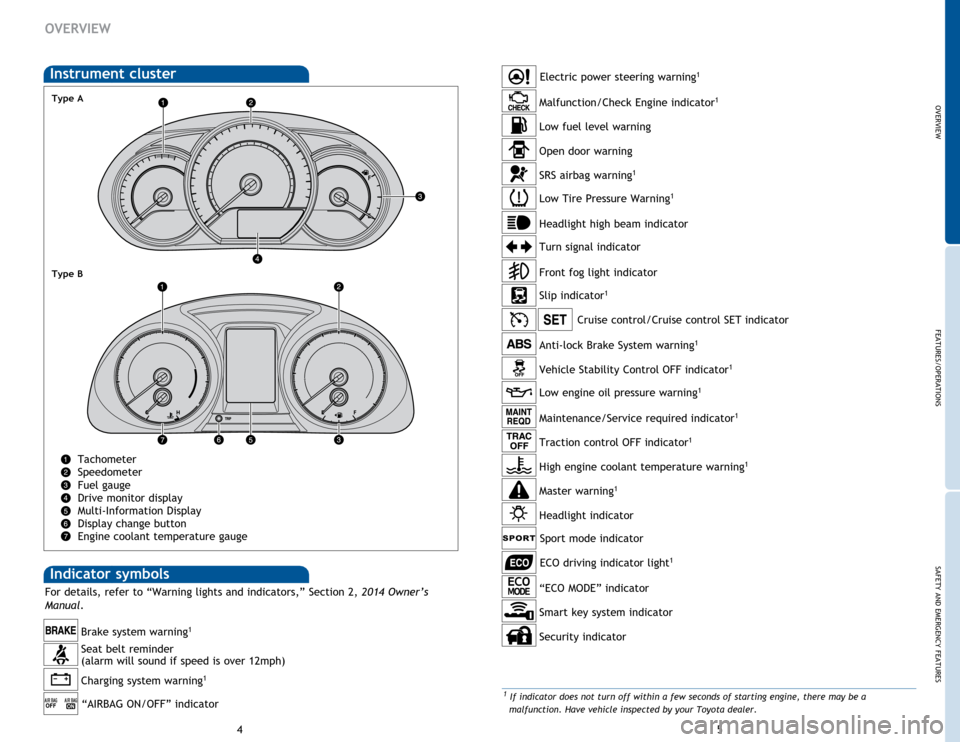
OVERVIEW
FEATURES/OPERATIONS
SAFETY AND EMERGENCY FEATURES
45
Indicator symbols
Charging system warning1
Brake system warning1
“AIRBAG ON/OFF” indicator
Anti-lock Brake System warning1
Headlight high beam indicator
Turn signal indicator
Slip indicator
1
Cruise control/Cruise control SET indicator
Low Tire Pressure Warning1
Open door warning
SRS airbag warning1
Malfunction/Check Engine indicator1
Low fuel level warning
Front fog light indicator
For details, refer to “Warning lights and indicators,” Section 2, 2014 Owner’s
Manual .
Low engine oil pressure warning1
Vehicle Stability Control OFF indicator1
Maintenance/Service required indicator1
Electric power steering warning1
1 If indicator does not turn off within a few seconds of starting engine, there may be a
malfunction. Have vehicle inspected by your Toyota dealer.
OVERVIEW
Instrument cluster
Tachometer
Speedometer
Fuel gauge
Drive monitor display
Multi-Information Display
Display change button
Engine coolant temperature gauge
Type A
Type B
Traction control OFF indicator1
Headlight indicator
High engine coolant temperature warning
1
Master warning1
Sport mode indicator
Security indicator
“ECO MODE” indicator
Smart key system indicator
ECO driving indicator light1
Seat belt reminder
(alarm will sound if speed is over 12mph)
Page 5 of 15
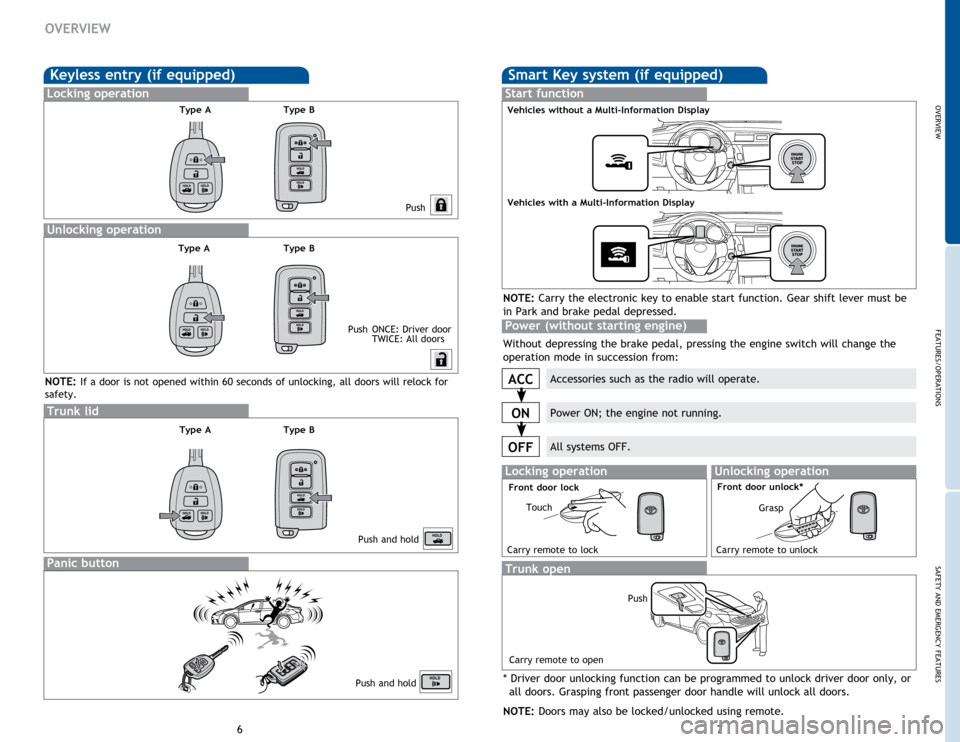
OVERVIEW
FEATURES/OPERATIONS
SAFETY AND EMERGENCY FEATURES
67
OVERVIEW
Keyless entry (if equipped)
Push
Push ONCE: Driver door
TWICE: All doors
Locking operation
Unlocking operation
Type A
Panic button
Push and hold
NOTE: If a door is not opened within 60 seconds of unlocking, all doors will relock for
safety.
Trunk lid
Push and hold
Type B
Type A
Type A Type B
Type B
Smart Key system (if equipped)
Start function
Accessories such as the radio will operate.
Power ON; the engine not running.
All systems OFF.
ACC
ON
OFF
NOTE: Carry the electronic key to enable start function. Gear shift lever must be
in Park and brake pedal depressed.
Without depressing the brake pedal, pressing the engine switch will change the
operation mode in succession from:
* Driver door unlocking function can be programmed to unlock driver door only, or
all doors. Grasping front passenger door handle will unlock all doors.
NOTE: Doors may also be locked/unlocked using remote.
Power (without starting engine)
Trunk open
Push
Locking operationUnlocking operation
Carry remote to lock Carry remote to unlock
Front door lock
Carry remote to open
Front door unlock*
Touch
Grasp
Vehicles without a Multi-Information Display
Vehicles with a Multi-Information Display
Page 7 of 15
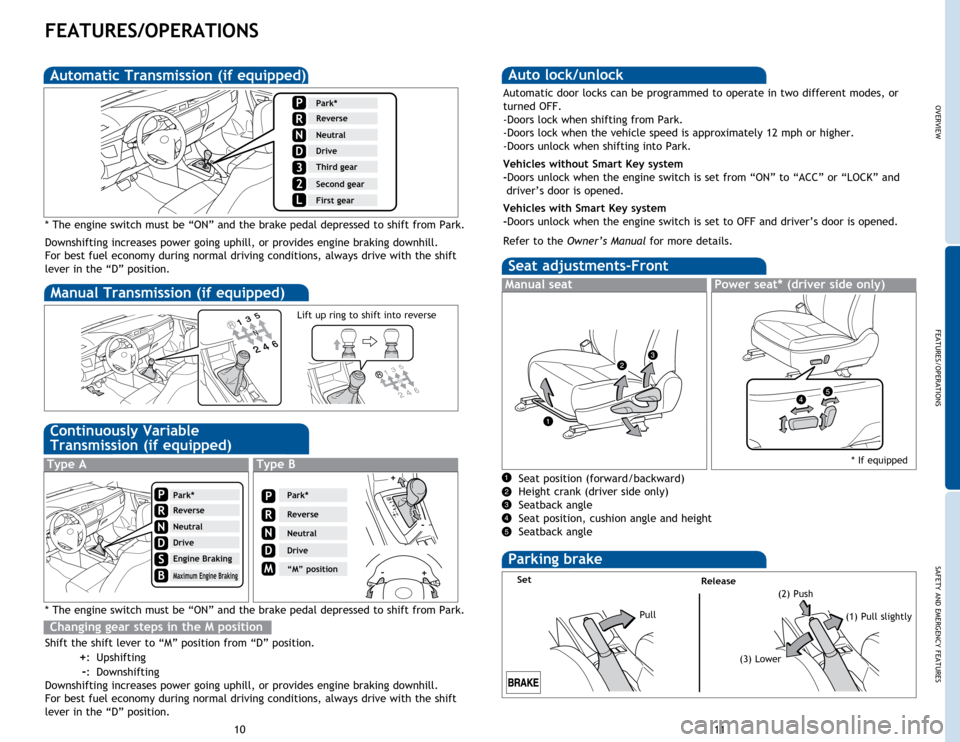
OVERVIEW
FEATURES/OPERATIONS
SAFETY AND EMERGENCY FEATURES
11
10
FEATURES/OPERATIONS
Auto lock/unlock
Automatic door locks can be programmed to operate in two different modes, or
turned OFF.
-Doors lock when shifting from Park.
-Doors lock when the vehicle speed is approximately 12 mph or higher.
-Doors unlock when shifting into Park.
Vehicles without Smart Key system
-Doors unlock when the engine switch is set from “ON” to “ACC” or “LOCK” and
driver’s door is opened.
Vehicles with Smart Key system
-Doors unlock when the engine switch is set to OFF and driver’s door is opened.
Refer to the Owner’s Manual for more details.
Seat position (forward/backward)
Height crank (driver side only)
Seatback angle
Seat position, cushion angle and height
Seatback angle
Automatic Transmission (if equipped)
Manual Transmission (if equipped)
* The engine switch must be “ON” and the brake pedal depressed to shift from Park.
Downshifting increases power going uphill, or provides engine braking downhill.
For best fuel economy during normal driving conditions, always drive with the shift
lever in the “D” position.
Type AType B
Parking brake
(2) Push
Lift up ring to shift into reverse
SetRelease
(1) Pull slightly
(3) Lower
Pull
Seat adjustments-Front
Manual seatPower seat* (driver side only)
Park*
Reverse
Neutral
Drive
Engine Braking
Maximum Engine Braking
S
B
P
R
N
D
* The engine switch must be “ON” and the brake pedal depressed to shift from Park.
Shift the shift lever to “M” position from “D” position.
+: Upshifting
-: Downshifting
Downshifting increases power going uphill, or provides engine braking downhill.
For best fuel economy during normal driving conditions, always drive with the shift
lever in the “D” position.
Changing gear steps in the M position
Park*
Reverse
Neutral
Drive
“M” position
P
R
N
D
M
+
+
-
-
Park*
Reverse
Neutral
Drive
Third gear
Second gear
First gear
3
2
L
P
R
N
D
Continuously Variable
Transmission (if equipped)
* If equipped
Page 8 of 15
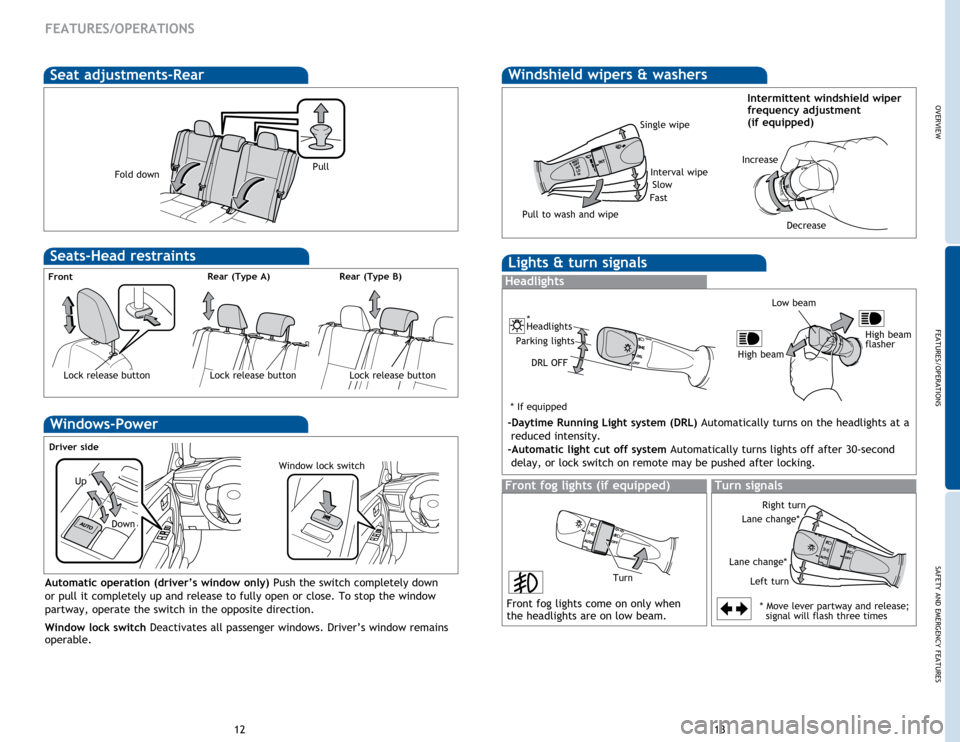
OVERVIEW
FEATURES/OPERATIONS
SAFETY AND EMERGENCY FEATURES
1213
FEATURES/OPERATIONS
Front fog lights (if equipped)
Front fog lights come on only when
the headlights are on low beam.
Turn
Turn signals
Right turn
Lane change*
Lane change* Left turn
Seats-Head restraints
Front Rear (Type B)
Rear (Type A)
Lock release buttonLock release buttonLock release button
Windshield wipers & washers
Interval wipe
Single wipe
Slow
Fast
Pull to wash and wipe
Windows-Power
Up
Down
Driver side
Window lock switch
Automatic operation (driver’s window only) Push the switch completely down
or pull it completely up and release to fully open or close. To stop the window
partway, operate the switch in the opposite direction.
Window lock switch Deactivates all passenger windows. Driver’s window remains
operable. Intermittent windshield wiper
frequency adjustment
(if equipped)
Increase
Decrease
Lights & turn signals
Headlights
High beam
-Daytime Running Light system (DRL) Automatically turns on the headlights at a
reduced intensity.
-Automatic light cut off system Automatically turns lights off after 30-second delay, or lock switch on remote may be pushed after locking.
High beam
flasher
* If equipped
* Move lever partway and release; signal will flash three times
*
Headlights
Parking lights
DRL OFF Low beam
Seat adjustments-Rear
Fold down
Pull
Page 11 of 15
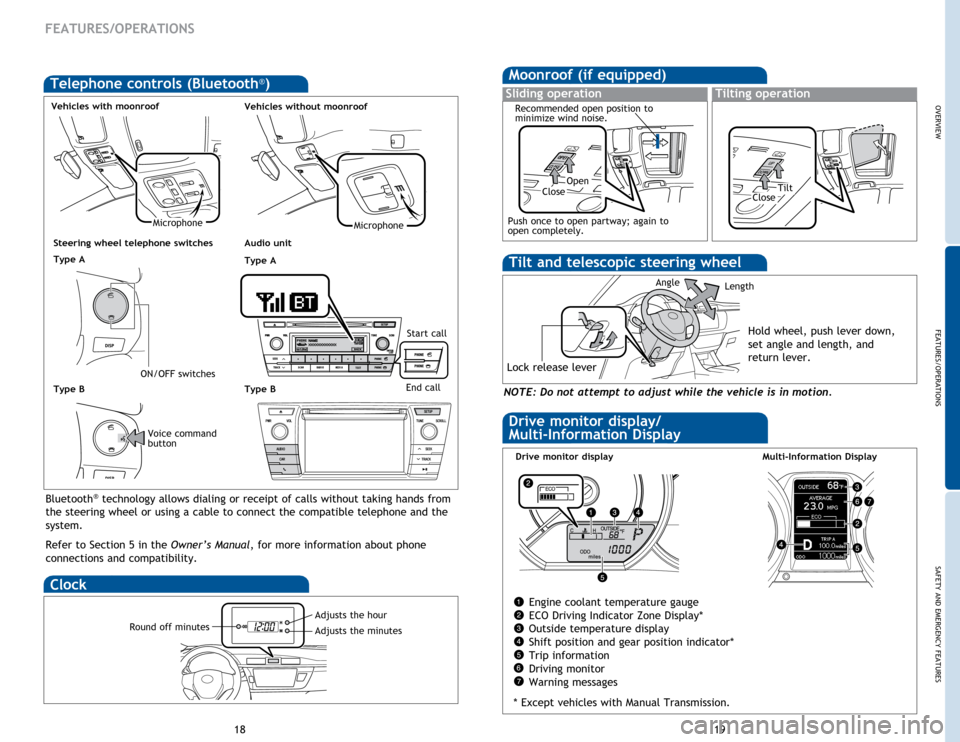
OVERVIEW
FEATURES/OPERATIONS
SAFETY AND EMERGENCY FEATURES
19
18
FEATURES/OPERATIONS
NOTE: Do not attempt to adjust while the vehicle is in motion.
Tilt and telescopic steering wheel
Lock release lever
AngleLength
Hold wheel, push lever down,
set angle and length, and
return lever.
Moonroof (if equipped)Telephone controls (Bluetooth®) Sliding operationTilting operation
OpenTiltCloseClose
Recommended open position to
minimize wind noise.
Bluetooth® technology allows dialing or receipt of calls without taking hands from
the steering wheel or using a cable to connect the compatible telephone and the
system.
Refer to Section 5 in the Owner’s Manual, for more information about phone
connections and compatibility.
Vehicles without moonroofVehicles with moonroof
Steering wheel telephone switches
ON/OFF switches
Push once to open partway; again to
open completely.
Type A
MicrophoneMicrophone
Audio unit
End call Start call
Voice command
button
Type B
Engine coolant temperature gauge
ECO Driving Indicator Zone Display*
Outside temperature display
Shift position and gear position indicator*
Trip information
Driving monitor
Warning messages
* Except vehicles with Manual Transmission.
Drive monitor display/
Multi-Information Display
Drive monitor displayMulti-Information Display
Clock
Adjusts the hourRound off minutesAdjusts the minutes
Type B
Type A
Page 12 of 15
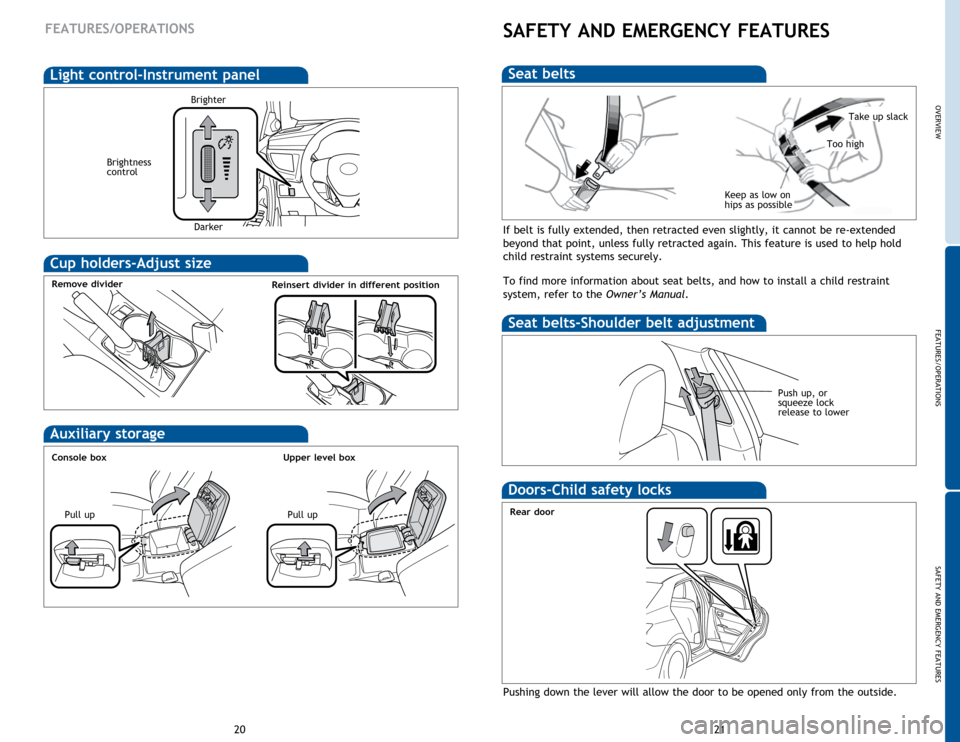
OVERVIEW
FEATURES/OPERATIONS
SAFETY AND EMERGENCY FEATURES
21
20
FEATURES/OPERATIONS
If belt is fully extended, then retracted even slightly, it cannot be re-extended
beyond that point, unless fully retracted again. This feature is used to help hold
child restraint systems securely.
To find more information about seat belts, and how to install a child restraint
system, refer to the Owner’s Manual.
Keep as low on
hips as possible
Take up slack
Too high
Seat belts
Push up, or
squeeze lock
release to lower
Seat belts-Shoulder belt adjustment
SAFETY AND EMERGENCY FEATURES
Cup holders-Adjust size
Remove divider
Auxiliary storage
Console boxUpper level box
Reinsert divider in different position
Pull up Pull up
Light control-Instrument panel
Brightness
control
Brighter
Darker
Pushing down the lever will allow the door to be opened only from the outside.
Rear door
Doors-Child safety locks
Page 14 of 15
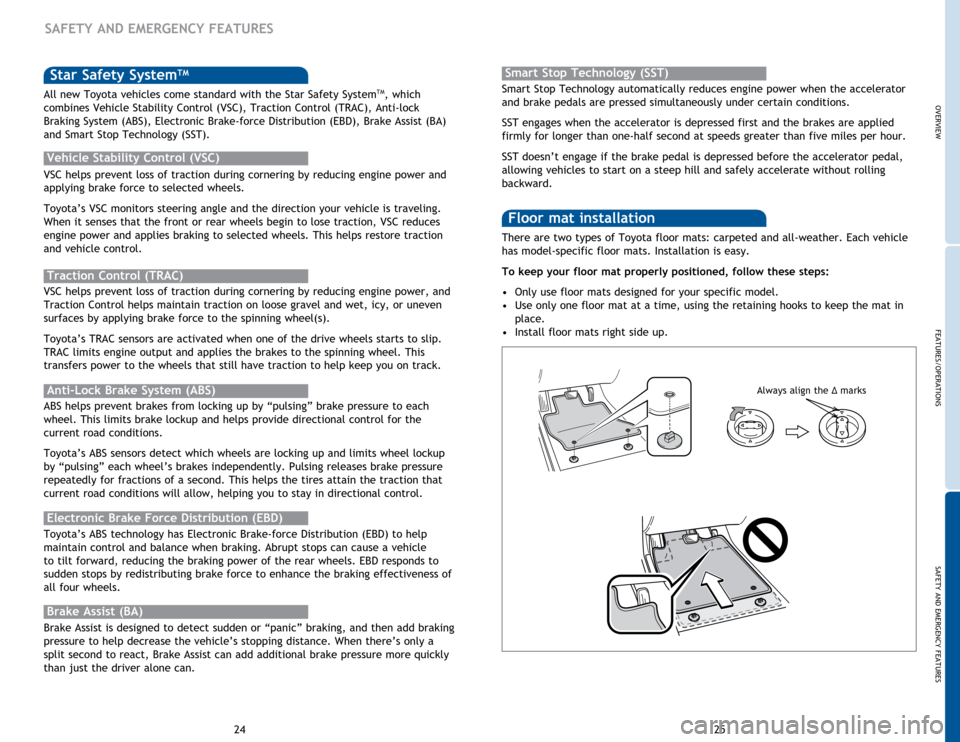
OVERVIEWFEATURES/OPERATIONS
SAFETY AND EMERGENCY FEATURES
25
24
SAFETY AND EMERGENCY FEATURES
Star Safety SystemTM
VSC helps prevent loss of traction during cornering by reducing engine power and
applying brake force to selected wheels.
Toyota’s VSC monitors steering angle and the direction your vehicle is traveling.
When it senses that the front or rear wheels begin to lose traction, VSC reduces
engine power and applies braking to selected wheels. This helps restore traction
and vehicle control.
Vehicle Stability Control (VSC)
Anti-Lock Brake System (ABS)
ABS helps prevent brakes from locking up by “pulsing” brake pressure to each
wheel. This limits brake lockup and helps provide directional control for the
current road conditions.
Toyota’s ABS sensors detect which wheels are locking up and limits wheel lockup
by “pulsing” each wheel’s brakes independently. Pulsing releases brake pressure
repeatedly for fractions of a second. This helps the tires attain the traction that
current road conditions will allow, helping you to stay in directional control.
Brake Assist (BA)
Brake Assist is designed to detect sudden or “panic” braking, and then add braking
pressure to help decrease the vehicle’s stopping distance. When there’s only a
split second to react, Brake Assist can add additional brake pressure more quickly
than just the driver alone can. VSC helps prevent loss of traction during cornering by reducing engine power, and
Traction Control helps maintain traction on loose gravel and wet, icy, or uneven
surfaces by applying brake force to the spinning wheel(s).
Toyota’s TRAC sensors are activated when one of the drive wheels starts to slip.
TRAC limits engine output and applies the brakes to the spinning wheel. This
transfers power to the wheels that still have traction to help keep you on track.
Traction Control (TRAC)
Electronic Brake Force Distribution (EBD)
Toyota’s ABS technology has Electronic Brake-force Distribution (EBD) to help
maintain control and balance when braking. Abrupt stops can cause a vehicle
to tilt forward, reducing the braking power of the rear wheels. EBD responds to
sudden stops by redistributing brake force to enhance the braking effectiveness of
all four wheels. There are two types of Toyota floor mats: carpeted and all-weather. Each vehicle
has model-specific floor mats. Installation is easy.
To keep your floor mat properly positioned, follow these steps:
• Only
use floor mats designed for your specific model.
• Use only one floor mat at a time, using the retaining hooks to keep the mat in
place.
• Install floor mats right side up.
Floor mat installation
All new Toyota vehicles come standard with the Star Safety SystemTM, which
combines Vehicle Stability Control (VSC), Traction Control (TRAC), Anti-lock
Braking System (ABS), Electronic Brake-force Distribution (EBD), Brake Assist (BA)
and Smart Stop Technology (SST). Smart Stop Technology automatically reduces engine power when the accelerator
and brake pedals are pressed simultaneously under certain conditions.
SST engages when the accelerator is depressed first and the brakes are applied
firmly for longer than one-half second at speeds greater than five miles per hour.
SST doesn’t engage if the brake pedal is depressed before the accelerator pedal,
allowing vehicles to start on a steep hill and safely accelerate without rolling
backward.
Smart Stop Technology (SST)
Always align the
Δ marks